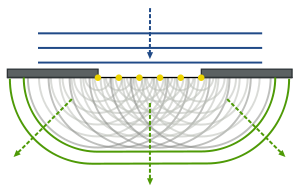Diffraction (water waves)

In the case of water waves, diffraction is understood to mean the diffraction of wave fronts at the ends of islands or at the edges of buildings. As with the diffraction of light at edges, Huygens' principle can also be used here . In the case of protective structures ( breakwaters and piers ), the diffraction of the wave fronts means that part of the energy of the incoming waves also gets behind the protective structure or in the area of a port entrance that is to be protected by moles against the effects of waves. When planning the port, unwanted wave effects with regard to harmful ship movements or possible silting up etc. a. using the diffraction coefficient
judged. Here refers to the height of the incoming waves and the height of waves by diffraction and possibly interference at the relevant place behind the building.
For the arrangement (top view) of two mole ends of a harbor entrance (distance B) with monochromatic wave fronts (wave height , wave length ), it is known that, due to interference, local wave heights occur in the axis of the entrance at a distance of several wavelengths when approaching with widths . Only at a greater distance from the passage do wave fronts (green) appear roughly parallel to those in front of the structures. Since the energy behind the structures is also distributed over the bent ridge lengths, the diffraction coefficient is and continues to decrease with increasing distance. In contrast, reflection occurs in front of the buildings .






